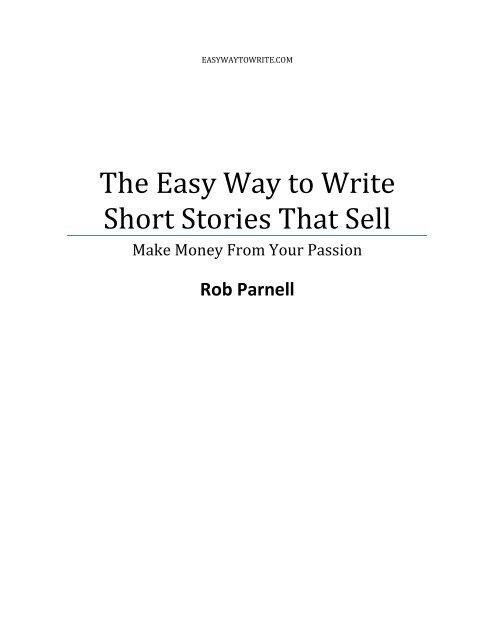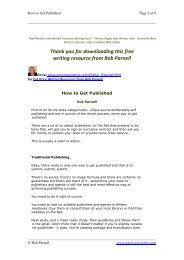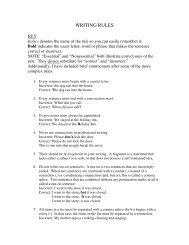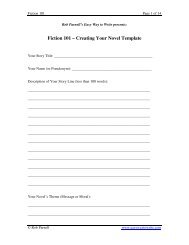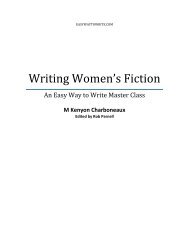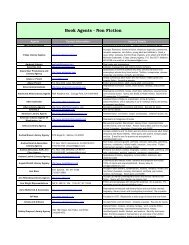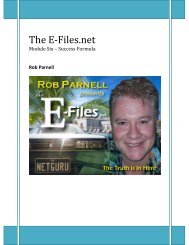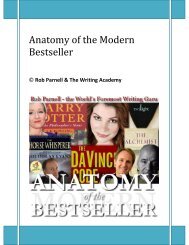The Easy Way to Write Short Stories That Sell
The Easy Way to Write Short Stories That Sell
The Easy Way to Write Short Stories That Sell
Create successful ePaper yourself
Turn your PDF publications into a flip-book with our unique Google optimized e-Paper software.
EASYWAYTOWRITE.COM<strong>The</strong> <strong>Easy</strong> <strong>Way</strong> <strong>to</strong> <strong>Write</strong><strong>Short</strong> S<strong>to</strong>ries <strong>That</strong> <strong>Sell</strong>Make Money From Your PassionRob Parnell
<strong>The</strong> <strong>Easy</strong> <strong>Way</strong> <strong>to</strong> <strong>Write</strong> <strong>Short</strong> S<strong>to</strong>ries <strong>That</strong> <strong>Sell</strong>About the <strong>Easy</strong> <strong>Way</strong> <strong>to</strong> <strong>Write</strong>Internationally renowned author and writing guru,Rob Parnell, is founder of the <strong>Easy</strong> <strong>Way</strong> <strong>to</strong> <strong>Write</strong>, an Internet companydedicated <strong>to</strong> providing excellent writing resources <strong>to</strong> writers of any proficiencyfrom the beginner <strong>to</strong> the seasoned pro. <strong>The</strong> <strong>Easy</strong> <strong>Way</strong> <strong>to</strong> <strong>Write</strong> offers e-booksand e-courses and many other writing services designed <strong>to</strong> help authors withanything from self-motivation and practical writing solutions <strong>to</strong> selling theirwork.You can sign up <strong>to</strong> free writing lessons and my free weekly newsletter here:http://www.easyway<strong>to</strong>write.comPS: When you’ve fully taken onboard the principle within these pages, it’s time<strong>to</strong> move on <strong>to</strong> other, more complex issues, like novel writing or building a careerfrom writing. <strong>The</strong> <strong>Easy</strong> <strong>Way</strong> <strong>to</strong> <strong>Write</strong> exists <strong>to</strong> help you.Over the past several years, hundreds of former EWTW students have gone on <strong>to</strong>become professional authors who earn good money from their writing.I know – because they’ve <strong>to</strong>ld me so!Take advantage of the unique <strong>Easy</strong> <strong>Way</strong> <strong>to</strong> <strong>Write</strong> philosophy and my powerfulresources in your own writing life. A good place <strong>to</strong> start is here:http://easyway<strong>to</strong>write.com/novel.html© Rob Parnell Page 2
<strong>The</strong> <strong>Easy</strong> <strong>Way</strong> <strong>to</strong> <strong>Write</strong> <strong>Short</strong> S<strong>to</strong>ries <strong>That</strong> <strong>Sell</strong>ContentsINTRODUCTIONPART ONE: MINDSETMental PreparationTime ManagementBeliefGoal SettingPART TWO: THE BASICSInspirationSubject MatterGenreScopeGetting IdeasPART THREE: CONSTRUCTION TIME<strong>The</strong> 7-Step S<strong>to</strong>ry Genera<strong>to</strong>rCharactersInteractionsS<strong>to</strong>rySetting<strong>The</strong> 5-Point Plot StructureStyle and TonePoint Of ViewTense© Rob Parnell Page 3
<strong>The</strong> <strong>Easy</strong> <strong>Way</strong> <strong>to</strong> <strong>Write</strong> <strong>Short</strong> S<strong>to</strong>ries <strong>That</strong> <strong>Sell</strong>Plotting<strong>The</strong> TwistBuilding a Template<strong>The</strong> ‘1-2-3-Bang’ and Other S<strong>to</strong>riesPART FOUR: WRITING YOUR STORY<strong>The</strong> Opening ParagraphFast WritingSecond DraftEditingFormattingPolishing -<strong>The</strong> Final EditPART FIVE: SUBMITTING YOUR WORKPresentation is the KeyIntroduction LetterRejectionRights & PaymentGood Examples of <strong>Short</strong> S<strong>to</strong>riesConclusionLegal Disclaimer: <strong>The</strong> contents of this report represent the views of its author. Nowarranty as <strong>to</strong> the efficacy and appropriateness of the advice and techniques mentionedor alluded <strong>to</strong> should be inferred. <strong>The</strong> author hereby disclaims any personal orprofessional loss or liability caused or alleged <strong>to</strong> be caused, directly or indirectly, by theuse of the information herein presented.<strong>The</strong> <strong>Easy</strong> <strong>Way</strong> <strong>to</strong> <strong>Write</strong> is copyright. www.easyway<strong>to</strong>write.com<strong>The</strong> Writing Academy (Australia), <strong>Write</strong>r’s Friend and RnR Media.No part of this publication can be reproduced without my express permission.Rob Parnell, PO Box 485 Morphett Vale, SA5162 Email: rob@easyway<strong>to</strong>write.com© Rob Parnell Page 4
<strong>The</strong> <strong>Easy</strong> <strong>Way</strong> <strong>to</strong> <strong>Write</strong> <strong>Short</strong> S<strong>to</strong>ries <strong>That</strong> <strong>Sell</strong>INTRODUCTIONWelcome, fellow writer!This brand new special report is an up-<strong>to</strong>-the-minute guide <strong>to</strong> helping youwrite excellent and salable short s<strong>to</strong>ries – the ‘<strong>Easy</strong> <strong>Way</strong> <strong>to</strong> <strong>Write</strong>’ way.It assumes you already know how <strong>to</strong> string a few sentences <strong>to</strong>gether and thatyou have written, or at least tried <strong>to</strong> write, a short s<strong>to</strong>ry or two.If you’ve ever submitted short s<strong>to</strong>ries for publication you may have gottendisillusioned very quickly. You may have received many rejections andwondered whether it was all worth it. Well, it is, and you may not haverealized just how close you were <strong>to</strong> an acceptance.Because, yes, getting short s<strong>to</strong>ries published is about persistence but it’s alsoimperative you get your submissions exactly right for your target markets.This report will outline what the requirements are and outline precisely how <strong>to</strong>construct the kind of s<strong>to</strong>ries edi<strong>to</strong>rs want <strong>to</strong> publish.This report is not just about giving you the basics of good writing. <strong>The</strong>re arelots of books out there that will do that, available at your local library orbooks<strong>to</strong>re. No, this report aims <strong>to</strong> do more, <strong>to</strong> give you much more specificadvice, based on the experience of the many published authors I have workedwith over the years, as well as my own experiences of getting s<strong>to</strong>ries in<strong>to</strong>print.© Rob Parnell Page 5
<strong>The</strong> <strong>Easy</strong> <strong>Way</strong> <strong>to</strong> <strong>Write</strong> <strong>Short</strong> S<strong>to</strong>ries <strong>That</strong> <strong>Sell</strong>Whilst there may never be a precise formula <strong>to</strong> getting published, there is asure fire way of being taken seriously by edi<strong>to</strong>rs and publishers.Believe it or not, edi<strong>to</strong>rs are fairly predictable. <strong>The</strong>y’re basically looking forthe same things in a good short s<strong>to</strong>ry.* Excellent presentation.* An interesting mind at work* A thorough grasp of the rules of writingWhen these three criteria are in evidence, a good short s<strong>to</strong>ry is almostinevitable. Which s<strong>to</strong>ry an edi<strong>to</strong>r then picks from the hundreds <strong>to</strong> choosefrom is down <strong>to</strong> the requirements of the particular publication and his/herpersonal preference.It may surprise you <strong>to</strong> learn that, for an edi<strong>to</strong>r, finding these qualities is theeasy part of the job.<strong>The</strong> hard part is wading through the 90% of all submitted material that ispoorly presented, badly executed and thinly thought out: all the stuff that endsup in the proverbial slush pile.Don’t you be part of that slush!Read this manual, absorb its teaching and I guarantee you’ll be in the <strong>to</strong>p tenpercent and seeing your work in print in no time.Enjoy!© Rob Parnell Page 6
<strong>The</strong> <strong>Easy</strong> <strong>Way</strong> <strong>to</strong> <strong>Write</strong> <strong>Short</strong> S<strong>to</strong>ries <strong>That</strong> <strong>Sell</strong>PART ONE: MINDSETMental PreparationBefore you venture in<strong>to</strong> writing proper, it’s important <strong>to</strong> have the rightmindset.Often, writers are good starters but poor finishers. Too often writers respond<strong>to</strong> an overwhelming compulsion <strong>to</strong> write without making appropriate plans <strong>to</strong>ensure a positive outcome. This is why writers get ‘stuck’ and can’t, or don’tknow how <strong>to</strong> complete their s<strong>to</strong>ries.Mental preparation is therefore vitally important.Before you start your short s<strong>to</strong>ries, you should spend time focusing on thebelief that you really can finish them. This may require some degree ofmeditation and visualization. If that sounds <strong>to</strong>o new age for you, call it‘talking <strong>to</strong> yourself’ if you prefer!You need <strong>to</strong> convince your subconscious mind that you are a good writer, andthat you are going <strong>to</strong> write and finish great short s<strong>to</strong>ries. Do this by makingpositive affirmations like,* I write well and easily. My work is infinitely publishable* I am a great writer, deserving of praise* I always complete the s<strong>to</strong>ries I startYou might feel silly saying these things <strong>to</strong> yourself. No matter, the© Rob Parnell Page 7
<strong>The</strong> <strong>Easy</strong> <strong>Way</strong> <strong>to</strong> <strong>Write</strong> <strong>Short</strong> S<strong>to</strong>ries <strong>That</strong> <strong>Sell</strong>subconscious does not discriminate. Say these things often enough and yourdeeper mind, where your dreams reside, will start <strong>to</strong> believe them.On a more practical level, write pieces that are self-contained, that is, theyhave a beginning, middle and end.Start small. Even just a couple of sentences and a paragraph or two are enough<strong>to</strong> begin with. Take simple ideas and write them down. For example, youcould write a few lines on making a cup of coffee or catching a bus <strong>to</strong> work.When you’ve put down the key elements in a piece of writing, go back andtighten up the words and sentences, edit until the rhythm of the piece hums.Finishing is the key. Get used <strong>to</strong> writing END after a piece. This is a goodway of teaching your brain that you always complete your written works.Time ManagementIn order <strong>to</strong> write well and effectively, you will need <strong>to</strong> set aside adequatewriting time.Nothing <strong>to</strong>o onerous at the start: say an hour a day. Or half an hour if that’s allyou can manage. Rhythm is the important thing. Writing thrives on routine.Writing 200 words a day is much better than writing 1400 words once a week.Set up a time everyday, ideally the same time, that you know you must dosome writing, and your subconscious will begin <strong>to</strong> look forward <strong>to</strong> those timesand perform accordingly.© Rob Parnell Page 8
<strong>The</strong> <strong>Easy</strong> <strong>Way</strong> <strong>to</strong> <strong>Write</strong> <strong>Short</strong> S<strong>to</strong>ries <strong>That</strong> <strong>Sell</strong>Make notes during the day about things you might want <strong>to</strong> write about. At thebeginning a writing session, get out those notes and add flesh <strong>to</strong> them. This isa good way <strong>to</strong> start and will counter any kind of ‘writer’s block.’Never stare at the wall or out of the window, waiting for divine intervention.Always write something, even if it’s trivial and lackluster. Professional writersrarely wait until they ‘feel like it’. Get used <strong>to</strong> writing the first thing thatcomes in<strong>to</strong> your head. It’s good practice.You should also train your mind in<strong>to</strong> writing pieces over particular timeframes. One short s<strong>to</strong>ry a month, for instance. Or a longer time span if needsbe.BeliefIt’s vital <strong>to</strong> engender a sense of purpose for your writing.Decide why you want <strong>to</strong> write short s<strong>to</strong>ries. Is it <strong>to</strong> entertain and enlightenothers, or is it something more personal? Do you simply need <strong>to</strong> satisfy avicarious desire <strong>to</strong> work? Or do you feel less than whole unless you can createsomething from nothing?Meditate on these issues for a few moments every day – perhaps when youwake in the morning or before you fall asleep at night. Plant some seeds ofpurpose in your subconscious mind and let the motivation <strong>to</strong> follow throughstew and bubble up in<strong>to</strong> your conscious mind.© Rob Parnell Page 9
<strong>The</strong> <strong>Easy</strong> <strong>Way</strong> <strong>to</strong> <strong>Write</strong> <strong>Short</strong> S<strong>to</strong>ries <strong>That</strong> <strong>Sell</strong>When you identify a good, urgent reason, write it down and carry it with youas a kind of Mission Statement. Read it often, say 5 or 6 times a day.Goal SettingWhen you have finished a few practice pieces and you’re sure you cansuccessfully move on, start <strong>to</strong> set goals. For instance,* I will write 500 words every day for a week.* I will write a 1000-word article and will write nothing else until it’s done.* I will do brief character outlines for my next short s<strong>to</strong>ryFocusing on goals is the first and last step when it comes <strong>to</strong> achievement.Nothing can happen in your life without you first knowing something can bedone and believing that you are capable of seeing it through.When you’ve done all of the above exercises and know in your heart thatfinishing a short s<strong>to</strong>ry is well within your grasp, only then is it time <strong>to</strong> moveon.© Rob Parnell Page 10
<strong>The</strong> <strong>Easy</strong> <strong>Way</strong> <strong>to</strong> <strong>Write</strong> <strong>Short</strong> S<strong>to</strong>ries <strong>That</strong> <strong>Sell</strong>PART TWO: THE BASICSInspirationInspiration is not an object or a substance. It doesn’t reside in little boxes,waiting <strong>to</strong> be found. It doesn’t live under rocks or grow on trees.If it’s anything at all it is an electrochemical reaction in the brain, usuallysparked by seeing, feeling or imagining something from a new perspective. Inall likelihood it’s a re-routing of the synapses that enable the brain <strong>to</strong> makeconnections of two or more disparate concepts interwoven or related in anapparently new way.Whatever it is, it’s personal.Though it happens rarely, even in the most prolific writer, inspiration has theadvantage that it can kick start you in<strong>to</strong> proceeding on a course of action,whether it be writing or some other activity. However, waiting for inspirationbefore you act is a mistake.For a start, you could have a long wait. It’s no<strong>to</strong>riously unreliable.For another, although your inspiration gives you the feeling you’re doingsomething original and important, edi<strong>to</strong>rs will tell you that this is largely anillusion. <strong>The</strong>y rarely see anything you might call ‘original’.In reality, no matter how profoundly you are moved by the notion your idea isunique and profound, it’s very unlikely that it is. Every time you think of a© Rob Parnell Page 11
<strong>The</strong> <strong>Easy</strong> <strong>Way</strong> <strong>to</strong> <strong>Write</strong> <strong>Short</strong> S<strong>to</strong>ries <strong>That</strong> <strong>Sell</strong>good idea, given the size of the planet, you can assume that about a millionother people simultaneously have exactly the same idea. Even if only 1% ofthose blessed with this new insight are writers they will also, like you, want <strong>to</strong>write it down and get it published!So, if that’s the reality, you might be asking, is it worth coming up withoriginal ideas? <strong>The</strong> short answer is probably no, it’s not.However, what can be original and unique is your slant, your style of writingand your interpretation of good ideas. Because, if you are true <strong>to</strong> yourselfand have faith in your vision, you will then be original.Subject MatterWhat interests you? Is it people, facts or plots?You can approach writing s<strong>to</strong>ries from many angles. However, those that arecharacter based are usually the most successful.You don’t have much time <strong>to</strong> impress a reader in a short s<strong>to</strong>ry. You must do itquickly and the easiest way <strong>to</strong> do that is <strong>to</strong> create a likable protagonist right upfront. If an edi<strong>to</strong>r likes your hero from the start, and believes a reader would<strong>to</strong>o, you’re at least halfway <strong>to</strong> getting published.Clever plots can make good short s<strong>to</strong>ries but if they don’t involve crediblepeople, the s<strong>to</strong>ry will always come across as hollow and contrived.Similarly, a few well-chosen or interesting facts, whether his<strong>to</strong>rical, scientific© Rob Parnell Page 12
<strong>The</strong> <strong>Easy</strong> <strong>Way</strong> <strong>to</strong> <strong>Write</strong> <strong>Short</strong> S<strong>to</strong>ries <strong>That</strong> <strong>Sell</strong>or perhaps mundane can make an interesting frame on which <strong>to</strong> hang a s<strong>to</strong>ry.But, without involving personalities, the facts alone will not entertain for long.As I’ve said many times before, without characters there’s no s<strong>to</strong>ry. <strong>The</strong>reforeit’s crucial you spend time working on your fictional personalities and makingthem real <strong>to</strong> you and more especially, the reader.You don’t need <strong>to</strong> be a master-psychiatrist or a sociologist <strong>to</strong> identify what’sinteresting about people. Even the most casual observer of humankind cangarner enough information <strong>to</strong> create a reasonably believable character.<strong>The</strong>y don’t have <strong>to</strong> be great leaders or beautifully attractive and talented.More often that not, the best short s<strong>to</strong>ries are not about the ‘big’ issues orprofound truths. Simple tales that highlight humanity’s traits and foibles in asensitive and appreciative way are the ones that engender our sympathy.When you’re wondering what would make a good subject or character for as<strong>to</strong>ry, don’t always try <strong>to</strong> see ‘significance’. Look <strong>to</strong>o at the trivial, the ornery,the average man or woman in the street.To remind a reader of a simple truth can be much more moving than trying <strong>to</strong>tackle and explain the meaning of the universe.GenreMany novice writers begin ‘literary’ in that they write about the real world,highlighting conventional relationships and surroundings using accepted© Rob Parnell Page 13
<strong>The</strong> <strong>Easy</strong> <strong>Way</strong> <strong>to</strong> <strong>Write</strong> <strong>Short</strong> S<strong>to</strong>ries <strong>That</strong> <strong>Sell</strong>writing conventions. Genre writing is more often than not seen as ‘less real’and as perhaps a product of lesser minds, equated with ‘selling out’ or writing<strong>to</strong> a formula.This is a strange attitude considering most of the best-selling authors of ourtime are in genre. Look at the work of John Grisham, Stephen King,Patricia Cornwell, Kathy Reichs, Dean Koontz, JK Rowling, DanielleSteel, James Patterson et al. <strong>The</strong>y are all essentially very well paid genrewriters.Perhaps ‘literary’ implies something al<strong>to</strong>gether more noble, deeper and morechallenging. However, many writers effectively hide behind the ‘literary’label <strong>to</strong> excuse their lack of success. <strong>The</strong>y maintain their principles won’t letthem write ‘that sort of thing.’<strong>The</strong> truth is of course that genre fiction is hard <strong>to</strong> get right. It’s going thatextra mile. <strong>The</strong> writer of genre not only knows how <strong>to</strong> write, he or she knowshow <strong>to</strong> tell s<strong>to</strong>ries. <strong>The</strong> genre writer knows that personality, place and plot –and knowing how <strong>to</strong> effectively combine those elements – can be just asimportant as having something interesting <strong>to</strong> say and writing well.Of course, whether you write literary or genre fiction will depend on yourpersonal temperament and preferences. But if you sincerely want <strong>to</strong> write forpublication, and be paid well for your efforts, these traits may well have <strong>to</strong>take a back seat <strong>to</strong> the needs of your target markets.<strong>The</strong> only sure fire way of getting published in a particular magazine is <strong>to</strong>study the s<strong>to</strong>ries they publish, and then write in that style.© Rob Parnell Page 14
<strong>The</strong> <strong>Easy</strong> <strong>Way</strong> <strong>to</strong> <strong>Write</strong> <strong>Short</strong> S<strong>to</strong>ries <strong>That</strong> <strong>Sell</strong>This might seem as the ultimate in ‘selling out’ but if you want <strong>to</strong> be asuccessful, full time writer or even just get a few s<strong>to</strong>ries published, it’s whatyou will need <strong>to</strong> do.And it really does work. Edi<strong>to</strong>rs know what they like and they know what’sright for their magazines. And simply put, if you write what they need, theywill want what you write.Take a chance and swallow your pride. <strong>Write</strong> for the market. Why not?You could spend years submitting your own s<strong>to</strong>ries, wondering why younever get published. Many people do, with no luck whatsoever.Edi<strong>to</strong>rs might think your work is wonderful. But they can’t publish s<strong>to</strong>ries thatare not right for their readers. <strong>The</strong> authors they publish closely study theirmarkets and their edi<strong>to</strong>rs. If you want <strong>to</strong> be pedantic yes, in effect they dowrite <strong>to</strong> order.But that’s the essential difference between the amateur and the professional.This one little compromise <strong>to</strong> your principles could be your key <strong>to</strong> success.Because it’s not selling out, it’s cashing in!ScopeAsk yourself now what sort of s<strong>to</strong>ries you want <strong>to</strong> write.© Rob Parnell Page 15
<strong>The</strong> <strong>Easy</strong> <strong>Way</strong> <strong>to</strong> <strong>Write</strong> <strong>Short</strong> S<strong>to</strong>ries <strong>That</strong> <strong>Sell</strong>Are they grand sweeping adventures or minute tableaus of passing moments?Most likely they’re somewhere in between.For most short s<strong>to</strong>ries you don’t want anything <strong>to</strong>o grand or overly ambitious.You only have a few thousand words <strong>to</strong> get across your s<strong>to</strong>ry succinctly. Toomuch detail and it will drag. Too little action and dialogue and your edi<strong>to</strong>r willnot make it <strong>to</strong> the end (I kid you not!) Conversely, <strong>to</strong>o many scenes and theedi<strong>to</strong>r will get lost and most likely bored.When you’re <strong>to</strong>ying with ideas, remember that you don’t want huge dramasspread across generations. You certainly don’t want affected language orverbosity. You don’t want any unnecessary back-s<strong>to</strong>ry clogging up the page orlots of static information imparted with no real enthusiasm or directness.All of these faults will get your MS heading for the return envelope faster thanthe time you spent licking the stamp!Always endeavor <strong>to</strong> imagine your s<strong>to</strong>ries simple in scope and theme, precisein direction as well as easy and fun <strong>to</strong> read.Getting IdeasIdeas are as personal as your own character. Not all writers will regard whatyou think is a good idea as a suitable reason <strong>to</strong> write. This doesn’t matter.What does matter is that you find it a good reason!Many writers will tell you they ideas from all sorts of places.© Rob Parnell Page 16
<strong>The</strong> <strong>Easy</strong> <strong>Way</strong> <strong>to</strong> <strong>Write</strong> <strong>Short</strong> S<strong>to</strong>ries <strong>That</strong> <strong>Sell</strong>* Overheard conversations* News items, movies, TV* Your own life incidents* Lateral thinking, mental Doodling, imagining* Other writing/writers, books, magazinesAll of these are valid, especially if you use your imagination <strong>to</strong> embellish onthem. Make notes on ideas that occur <strong>to</strong> you. <strong>Write</strong> down snatches ofconversation. Keep a notebook <strong>to</strong> put quick plot ideas in. Describe interestingpeople you meet.Don’t get <strong>to</strong>o carried away with the notion that you must have a completes<strong>to</strong>ry idea before you start making notes. Many s<strong>to</strong>ries start out from thehumblest beginnings.© Rob Parnell Page 17
<strong>The</strong> <strong>Easy</strong> <strong>Way</strong> <strong>to</strong> <strong>Write</strong> <strong>Short</strong> S<strong>to</strong>ries <strong>That</strong> <strong>Sell</strong>PART THREE: CONSTRUCTION TIME<strong>The</strong> 7-Step S<strong>to</strong>ry Genera<strong>to</strong>rIf you’re stuck for ideas, don’t panic, try this foolproof strategy for coming upwith a s<strong>to</strong>ry.1. Create 1 <strong>to</strong> 3 interesting characters2. Describe their personalities, characteristics and their agendas3. Make their individual goals at odds with the other characters’4. Start making notes on how your characters interact5. Explore how each of the characters will achieve their goals6. Let you characters suggest the s<strong>to</strong>ry, easily and naturally7. S<strong>to</strong>p when you have a s<strong>to</strong>ry idea.<strong>The</strong> above exercise should take you about 10 minutes <strong>to</strong> half an hour. At theend you should have an interesting scenario that might develop in<strong>to</strong> a goodshort s<strong>to</strong>ry. If not, try it again with different characters.Do a few of these exercises, for practice.CharactersI only endorse one way of writing s<strong>to</strong>ries.Characters first and every time, and in a short s<strong>to</strong>ry, as few as possible. Morethan three <strong>to</strong> five gets hard <strong>to</strong> follow. If your s<strong>to</strong>ry idea contains more thanfive, consider cutting a few out. If you don’t know how <strong>to</strong> do that, try creating© Rob Parnell Page 18
<strong>The</strong> <strong>Easy</strong> <strong>Way</strong> <strong>to</strong> <strong>Write</strong> <strong>Short</strong> S<strong>to</strong>ries <strong>That</strong> <strong>Sell</strong>what Hollywood calls ‘composite’ characters. You might have say, a sister, abest friend and a doc<strong>to</strong>r that all need <strong>to</strong> give advice <strong>to</strong> your hero. Roll all threecharacters in<strong>to</strong> one.This is an especially useful technique when it comes <strong>to</strong> novels andscreenplays, where character numbers can quickly get out of hand.Creating good, strong and believable characters is your number one prioritywhen it comes <strong>to</strong> fiction writing. As a habit, you should spend timedeveloping them, writing out their his<strong>to</strong>ries and goals etc.For the purposes of the short s<strong>to</strong>ry, you usually don’t need <strong>to</strong>o much detail.<strong>The</strong>y don’t need <strong>to</strong> be as fleshed out as you would require in a larger work.Too much depth, as in conflicting emotions, deep psychological traits aregenerally inappropriate for a short s<strong>to</strong>ry and might detract.Take one of your characters and do a shorthand sketch of their:· Physical attributes· Psychological attributes· Nationality· Age· Profession• Two important goals• Personal traits or talents that might help or hinder those goals• Finally give him/her a name.© Rob Parnell Page 19
<strong>The</strong> <strong>Easy</strong> <strong>Way</strong> <strong>to</strong> <strong>Write</strong> <strong>Short</strong> S<strong>to</strong>ries <strong>That</strong> <strong>Sell</strong>Note: Don’t name them <strong>to</strong>o early. It can color your creativity.You should find this is more than enough <strong>to</strong> add flesh <strong>to</strong> characters and isperhaps more than you will need <strong>to</strong> mention about them in your s<strong>to</strong>ry.Use any spare time you have getting <strong>to</strong> know your characters. This is alwaysmore important than any plot consideration or s<strong>to</strong>ry invention. Trust me. Youare more likely <strong>to</strong> be rejected because your characters are one dimensional andunconvincing than if your plot is bad.InteractionsOnce you have two or three characters you like, write some dialogue betweenthem. Make sure they are at odds with each other. If it feels right, make themviolently disagree with each other. <strong>The</strong>se conversations should be dramatic,each one playing devil’s advocate with the other’s point of view. <strong>That</strong>’s theidea. If there’s <strong>to</strong>o much agreement between your characters, you s<strong>to</strong>ry willmost likely be dull.Make notes about their relationship with each other. Establish what they are <strong>to</strong>your satisfaction before you move on <strong>to</strong>:S<strong>to</strong>ryOnce you know your characters well and you like the way they interact, start<strong>to</strong> think of how their relationships might evolve in<strong>to</strong> a plot.Start with a simple idea and see how far you can push it. Think laterally but© Rob Parnell Page 20
<strong>The</strong> <strong>Easy</strong> <strong>Way</strong> <strong>to</strong> <strong>Write</strong> <strong>Short</strong> S<strong>to</strong>ries <strong>That</strong> <strong>Sell</strong>don’t force your characters in<strong>to</strong> doing things they’re not happy with. Yourcharacters must remain consistent. It’s okay <strong>to</strong> put them in<strong>to</strong> situations that areunfamiliar but they must react <strong>to</strong> those situations with credibility.And remember a golden rule: they must already have the necessary attributes<strong>to</strong> escape or overcome any and all obstacles.SettingYou may have already had some idea where you are going <strong>to</strong> set your s<strong>to</strong>ry.Think hard about it now. Is there some reason why it has <strong>to</strong> set in a particularplace? Perhaps you could transplant the action <strong>to</strong> somewhere else in time andspace. <strong>The</strong>re’s no real limit.But perhaps you have a thriller that requires a local quirk of law that requiresyour s<strong>to</strong>ry <strong>to</strong> be set in Cuba for instance. All well and good, as long as you’vebeen there and can write about it convincingly.Remember in your s<strong>to</strong>ry that setting is the other character. It is as important<strong>to</strong> your s<strong>to</strong>ry as the people in it because it gives them context and can ideallybe used <strong>to</strong> heighten drama and tension, depending on where it is.<strong>The</strong> 5-Point Plot StructureIt doesn’t have <strong>to</strong> have just five points but for a short s<strong>to</strong>ry, it’s a good startingpoint.Think back <strong>to</strong> the essays you did at school. This was the basic structure:© Rob Parnell Page 21
<strong>The</strong> <strong>Easy</strong> <strong>Way</strong> <strong>to</strong> <strong>Write</strong> <strong>Short</strong> S<strong>to</strong>ries <strong>That</strong> <strong>Sell</strong>1. Terms of reference2. Agenda3. Premise4. Discussion5. ResolutionWell, this was how we did it at my school. Probably yours was different! Nomatter. A good short s<strong>to</strong>ry follows the same kind of format.1. Opening sequence2. <strong>The</strong> central idea3. Obstacles4. Overcoming5. CloseUse this structure <strong>to</strong> outline a s<strong>to</strong>ry idea. For instance,1. Jack’s wife calls, distraught2. Jack must find wife3. His mistress won’t let him go4. <strong>The</strong>y go <strong>to</strong>gether5. <strong>The</strong>y discover she’s deadOkay, this particular s<strong>to</strong>ry might not look <strong>to</strong>o promising at this stage but itdoesn’t need <strong>to</strong> be. We just need the basics and have a good idea of who,where and how things are going <strong>to</strong> happen, and that the idea has structure.© Rob Parnell Page 22
<strong>The</strong> <strong>Easy</strong> <strong>Way</strong> <strong>to</strong> <strong>Write</strong> <strong>Short</strong> S<strong>to</strong>ries <strong>That</strong> <strong>Sell</strong>Remember, keep it simple. Don’t use up hundreds of ideas on one s<strong>to</strong>ry. Usejust one or two, that’s all you need. It’ll help give your writing room <strong>to</strong>breathe.Style and ToneAbout now, you’re probably itching <strong>to</strong> get started on your s<strong>to</strong>ry. Hold back fora little longer. You have a few more decisions <strong>to</strong> make.How are you going <strong>to</strong> write your s<strong>to</strong>ry?With short sharp sentences? Starkly? Or moody with lots of description?Chatty and informal? Dark and/or gothic?Rather than agonize over this decision, go with whatever you feel you cansustain for a whole s<strong>to</strong>ry. Your style should be easy and consistent. Don’t takeon a <strong>to</strong>ne of voice that’s not natural <strong>to</strong> you.Decide now <strong>to</strong> write your s<strong>to</strong>ry as fast as you can.Edi<strong>to</strong>rs often complain that s<strong>to</strong>ries seem <strong>to</strong> change <strong>to</strong>ne or even direction halfway through. This is usually caused by taking <strong>to</strong>o long <strong>to</strong> write a s<strong>to</strong>ry, or byleaving long gaps between writing sessions. You are literally a differentperson each time you sit down <strong>to</strong> write…and it shows.Also, writers tend <strong>to</strong> change their minds about a s<strong>to</strong>ry as they go along. Notgood. Professionals know that consistent <strong>to</strong>ne is a must for each s<strong>to</strong>ry. If it’snot convincingly <strong>to</strong>ld in one voice, then later, when you edit, you must take© Rob Parnell Page 23
<strong>The</strong> <strong>Easy</strong> <strong>Way</strong> <strong>to</strong> <strong>Write</strong> <strong>Short</strong> S<strong>to</strong>ries <strong>That</strong> <strong>Sell</strong>out everything that doesn’t fit.Better <strong>to</strong> do it right first time. Pick an easy and natural style and stick with it.Point Of ViewPretty soon you’ll need <strong>to</strong> decide from whose point of view you’re going <strong>to</strong> betelling the s<strong>to</strong>ry. It’s best <strong>to</strong> stick with just one – your hero or heroine – for ashort s<strong>to</strong>ry. Too many POVs in a s<strong>to</strong>ry and you’re going <strong>to</strong> confuse the reader.<strong>That</strong> doesn’t mean you can’t have more than one character, only that theworld can only be seen through the eyes (and feelings) of one. Be careful not<strong>to</strong> read the thoughts of others in your s<strong>to</strong>ry. It’s easily done but the ‘modern’way is increasingly <strong>to</strong> tell s<strong>to</strong>ries from only one POV at a time.Now <strong>to</strong>o, will be the time <strong>to</strong> decide whether you’re going <strong>to</strong> be telling thes<strong>to</strong>ry from the first person, that is, an ‘I’ s<strong>to</strong>ry.Experiment with a paragraph or two, telling the same scene in both modes:Compare the following:<strong>The</strong> man s<strong>to</strong>od on the edge of the cliff, staring out <strong>to</strong> sea. He noticeda boat, gray and indistinct on the distant horizon. He wondered idlywhere it was bound. <strong>The</strong>n he thought about Jane, how he’d hurt herrecently and how much he regretted it.With,© Rob Parnell Page 24
<strong>The</strong> <strong>Easy</strong> <strong>Way</strong> <strong>to</strong> <strong>Write</strong> <strong>Short</strong> S<strong>to</strong>ries <strong>That</strong> <strong>Sell</strong>I s<strong>to</strong>od on the edge of the cliff, staring out <strong>to</strong> sea. I noticed a boat,gray and indistinct on the distant horizon. I wondered idly where itwas bound. <strong>The</strong>n I remembered Jane and how I’d hurt her recentlyand how much I regretted it.<strong>The</strong> second scene is more personal and perhaps pulls you in<strong>to</strong> the s<strong>to</strong>ry more.‘I’ s<strong>to</strong>ries work well for the first time writer. You may have plots problemsthough because you cannot ‘witness’ events you are not directly involved in.Experiment <strong>to</strong> see what’s right for your s<strong>to</strong>ry.TenseWhile we’re on the subject, tense can make a huge difference <strong>to</strong> a s<strong>to</strong>ry. Takea look at the same passage in the present tense,I stand on the edge of the cliff, staring out <strong>to</strong> sea. I notice a boat,gray and indistinct on the distant horizon. I wonder idly where it’sbound. I remember Jane, how I hurt her recently and how muchI regret it.Odd how such a little change can throw the scene in<strong>to</strong> a new light, don’t youthink?<strong>The</strong> classic way <strong>to</strong> tell s<strong>to</strong>ries is ‘immediate’ past tense. This has become thenorm. It’s so common that readers take it for granted. Although technically theevents are over and gone, readers feel they are right there as it’s happening.© Rob Parnell Page 25
<strong>The</strong> <strong>Easy</strong> <strong>Way</strong> <strong>to</strong> <strong>Write</strong> <strong>Short</strong> S<strong>to</strong>ries <strong>That</strong> <strong>Sell</strong>I’d advise <strong>to</strong> stick with it for ease of s<strong>to</strong>rytelling.Present tense can be arresting, though sometimes it’s just annoying. Use itsparingly. Also, unless you’re careful, it can be difficult <strong>to</strong> maintain withoutaccidentally slipping back in<strong>to</strong> the past tense.PlottingGet your 5-point s<strong>to</strong>ry plan out now.Take a piece of paper, write START in the bot<strong>to</strong>m left hand corner and ENDin the <strong>to</strong>p right. Draw four vertical lines down the page, so that you end upwith five sections. At the <strong>to</strong>p of these sections write your 5 plot pointheadings. Like this:START1 2 3 4 5END<strong>Write</strong> a S<strong>to</strong>ry Statement beneath the word START. Your ‘s<strong>to</strong>ry statement’ isa short sentence describing what your s<strong>to</strong>ry is about, its theme, point or moral.For example,* John overcomes shyness <strong>to</strong> get a date.* Sandra kills her demons <strong>to</strong> get back her sanity.* Love conquers the local hoodlum© Rob Parnell Page 26
<strong>The</strong> <strong>Easy</strong> <strong>Way</strong> <strong>to</strong> <strong>Write</strong> <strong>Short</strong> S<strong>to</strong>ries <strong>That</strong> <strong>Sell</strong>Now write a series of plot points going up the diagonal line -across the page.This is a physical representation of your s<strong>to</strong>ry. Does the tension andexcitement escalate as you move from left <strong>to</strong> right? It should.If not, rearrange you plot points so that the s<strong>to</strong>ry intensifies <strong>to</strong>wards the end.Keep changing and rearranging your plot points until you’re sure your s<strong>to</strong>ry isthe best it can be. Give weight <strong>to</strong> the events that matter. Consider choppingevents that do not. Do the same with characters. Can you s<strong>to</strong>ry be <strong>to</strong>ld withoutcertain characters al<strong>to</strong>gether? Can two become one? Can several become acomposite?Are you duplicating plot events? Remember, the simpler the s<strong>to</strong>ry the better.Like a good joke, it’s brief, nothing is wasted and every line is there for areason. Here’s some advice: If in doubt, chop it out.Now, when you’ve done all that, just under the word END, write your twist.<strong>That</strong>’s right. Sorry <strong>to</strong> spring that on you…but that was the idea!<strong>The</strong> TwistI’m going <strong>to</strong> let you in on a secret now. Whatever happens in your plot oryour s<strong>to</strong>ry, in order <strong>to</strong> make your work infinitely more salable, you must havea twist.This is the secret weapon of the intelligent author. Edi<strong>to</strong>rs – and readers lovethem. <strong>The</strong>y are satisfying. <strong>The</strong>y show cleverness. <strong>The</strong>y show that you,© Rob Parnell Page 27
<strong>The</strong> <strong>Easy</strong> <strong>Way</strong> <strong>to</strong> <strong>Write</strong> <strong>Short</strong> S<strong>to</strong>ries <strong>That</strong> <strong>Sell</strong>the writer, have a complete grasp of the short s<strong>to</strong>ry medium.With this simple technique, you’ve shown you don’t just make things up asyou go along, and this particular s<strong>to</strong>ry isn’t good because of some fluke.You’ve shown you can prepare and synthesize a whole s<strong>to</strong>ry before youstart. With this one little trick, you mark yourself out as serious about yourcraft. You come across as the consummate professional!Why? Because, as any good edi<strong>to</strong>r knows, the only way <strong>to</strong> have a good,convincing twist at the end of your s<strong>to</strong>ry is know what it is before you start.Because only by knowing your own twist can you write the whole s<strong>to</strong>rysteering the edi<strong>to</strong>r/reader away from guessing it!When the edi<strong>to</strong>r gets <strong>to</strong> the end of a s<strong>to</strong>ry and realizes he has been <strong>to</strong> someextent ‘duped’ by your writing skills, he is impressed and instantly considersyou a superior writer, and one <strong>to</strong> watch.So, if you want <strong>to</strong> be a paid writer quickly and often, imprint this simplemessage on your brain:<strong>The</strong>re must be a twist at the end of your s<strong>to</strong>ry AND you must knowwhat it’s going <strong>to</strong> be before you start writing!It may be thin and flimsy, it may be profound, it may be enigmatic. It cancause a smile, a smirk or just raise an eyebrow. It doesn’t matter <strong>to</strong>o much, aslong as it’s there.Trust me.© Rob Parnell Page 28
<strong>The</strong> <strong>Easy</strong> <strong>Way</strong> <strong>to</strong> <strong>Write</strong> <strong>Short</strong> S<strong>to</strong>ries <strong>That</strong> <strong>Sell</strong>Building a TemplateTake your plot points from the previous exercise. Copy them (in their mosteffective order) and list them down the left hand side of your word processorscreen or page.Put spaces between them.In the spaces, fill in the gaps between the plot points with any action, scenes,dialogue cues and other information you think you will need <strong>to</strong> take yousmoothly from one plot point <strong>to</strong> the next. Don’t put in trivial actions likewaking up, going <strong>to</strong> the shops and eating meals unless they have a directbearing on the s<strong>to</strong>ry.When you’ve finished you should less than a page of notes or s<strong>to</strong>ry, buteverything will be in the right order.This is the template you will use <strong>to</strong> write your short s<strong>to</strong>ry.You need this because as you write, you won’t get stuck because you willalways know what comes next.And don’t think you can shirk on this.I’ve lost count of the number of times writers email me <strong>to</strong> say,Yeah, I understand the template idea but, Rob, I don’t work that© Rob Parnell Page 29
<strong>The</strong> <strong>Easy</strong> <strong>Way</strong> <strong>to</strong> <strong>Write</strong> <strong>Short</strong> S<strong>to</strong>ries <strong>That</strong> <strong>Sell</strong>way. I like <strong>to</strong> make it up as I go along.And then, I wait. Yep, and almost every single time it’s these same writerswho get back <strong>to</strong> me and say,Oh, hi Rob, um, I’m about two thirds of the way through and kind ofstuck, um, I don’t really know where <strong>to</strong> go with this s<strong>to</strong>ry now.You have no idea how hard it is <strong>to</strong> hold back saying, I <strong>to</strong>ld you so!<strong>The</strong> ‘1-2-3-Bang’ and Other S<strong>to</strong>riesAt this point you’ll be getting an idea how long your s<strong>to</strong>ry will be.In most instances you will be writing <strong>to</strong> a pre-determined length set bypublisher’s guidelines.Here’s a quick overview of modern s<strong>to</strong>ry lengths:Flash fiction is usually between 50 and 200 words. <strong>The</strong> medium is becomingmore and more popular as the attention span of the average reader diminishes.Some blame TV. I blame the magazines themselves.When you read a magazine filled with ads and articles designed <strong>to</strong> entertainand divert you in the shortest time possible, why would readers want <strong>to</strong> lingerover a page full of dense text?Mini s<strong>to</strong>ries usually come in at around a 1000 words. Modern True Love or© Rob Parnell Page 30
<strong>The</strong> <strong>Easy</strong> <strong>Way</strong> <strong>to</strong> <strong>Write</strong> <strong>Short</strong> S<strong>to</strong>ries <strong>That</strong> <strong>Sell</strong>Romances fall in<strong>to</strong> this category and follow a formula which I call the 1-2-3Bangformat, as in,1. Obstacle,2. Obstacle,3. Resolution?BANG: <strong>The</strong> twist.Typified by this sort of s<strong>to</strong>ry:1. Jeremy thinks his wife is having an affair with his best friend.2. He follows them <strong>to</strong> a travel agent – they’re buying tickets <strong>to</strong> Paris.3. He confronts them and they are red-faced, denying everything.BANG: <strong>The</strong> tickets are for him and his wife, it’s his birthday surprise.I’m sure you could think of hundreds similar and have read quite a few indentist’s waiting rooms!Most serious Magazine Fiction is between 1000 <strong>to</strong> 3000 wordsAnything up <strong>to</strong> 3000 words should ideally not have a much in the way of asubplot. It’s <strong>to</strong>o confusing, It should be a linear s<strong>to</strong>ry of events leading <strong>to</strong> alogical conclusion.In most ‘S<strong>to</strong>ry Magazines’, as in publications specifically designed <strong>to</strong> carryshort s<strong>to</strong>ries, you can usually write up <strong>to</strong> 5000 words. Perhaps containing onesubplot or an item of interest outside of the linear format.Books and <strong>Short</strong> S<strong>to</strong>ry Compilations can carry s<strong>to</strong>ries up <strong>to</strong> 10000, even© Rob Parnell Page 31
<strong>The</strong> <strong>Easy</strong> <strong>Way</strong> <strong>to</strong> <strong>Write</strong> <strong>Short</strong> S<strong>to</strong>ries <strong>That</strong> <strong>Sell</strong>15000 words but you normally have <strong>to</strong> be a ‘name’ <strong>to</strong> get all that space in abook!<strong>The</strong>se latter publications are commonly printed by independent edi<strong>to</strong>rslicensed through a major publisher. Contrary <strong>to</strong> the way it can appear, theedi<strong>to</strong>rs of these books don’t usually scour magazines for good s<strong>to</strong>ries <strong>to</strong>republish. <strong>The</strong>y usually release a ‘call for submissions’ <strong>to</strong> recognized anddependable authors, agents and reputable writer’s associations. <strong>The</strong> authorsthen submit work which may have been published elsewhere.Note: Even then, these authors will only submit work <strong>to</strong> the guidelines in the‘call for submissions’ or else write specifically <strong>to</strong> fulfill them. Even the prosdo it right. But then, that’s probably how they got <strong>to</strong> be pros!Anything over between 10,000 and 50000 would more commonly be called aNovella. Anything beyond that, a fully-fledged Novel, and is outside of theremit of this report.But, of course, I couldn’t go on without mentioning that for the ultimateguide <strong>to</strong> writing novel length fiction, you must get a copy of the “<strong>The</strong> <strong>Easy</strong><strong>Way</strong> <strong>to</strong> <strong>Write</strong> A Novel”. It’s a classic work, highly praised and recognized asa ‘must have’ for an aspiring author.© Rob Parnell Page 32
<strong>The</strong> <strong>Easy</strong> <strong>Way</strong> <strong>to</strong> <strong>Write</strong> <strong>Short</strong> S<strong>to</strong>ries <strong>That</strong> <strong>Sell</strong>PART FOUR: WRITING YOUR STORY<strong>The</strong> Opening ParagraphPrepare yourself for a shock. After all your hard work, thought andinspiration, an edi<strong>to</strong>r will rarely read more than your opening paragraph.Sometimes not even that.<strong>The</strong>y simply don’t have the time. Besides, <strong>to</strong> their way of thinking, the firstparagraph is your opening gambit, it is your attempt <strong>to</strong> snag a reader’sattention. If you can’t do that, or don’t even try, why would the edi<strong>to</strong>r thinkthe rest of your s<strong>to</strong>ry is worth reading?Your opening is the most important part of your s<strong>to</strong>ry. Without a goodopening, you’re dead in the water.And yet good openings are hard <strong>to</strong> get right. <strong>That</strong>’s why it’s worth spendingtime on them, even when you have the s<strong>to</strong>ry completed. Always go back <strong>to</strong>the beginning and ask yourself if it’s strong enough.Your opening should be intriguing. It should place a question in the reader’smind at once, even if it’s, ‘What’s going on?’<strong>The</strong> ‘real’ start of a s<strong>to</strong>ry is also one of the most difficult things <strong>to</strong> identify.<strong>The</strong> standard advice is this:Start writing, working your way in<strong>to</strong> your s<strong>to</strong>ry with ease and confidence.© Rob Parnell Page 33
<strong>The</strong> <strong>Easy</strong> <strong>Way</strong> <strong>to</strong> <strong>Write</strong> <strong>Short</strong> S<strong>to</strong>ries <strong>That</strong> <strong>Sell</strong><strong>The</strong>n, when you go back, you’ll probably find your ‘real’ intro somewherearound 200 <strong>to</strong> 400 words in. Authors are no<strong>to</strong>rious for wanting <strong>to</strong> seteverything up before a piece of drama. In a short s<strong>to</strong>ry, you don’t have time <strong>to</strong>set up anything. It’s a luxury you don’t need.Quite the opposite, <strong>to</strong>o much setting up is boring. Learn <strong>to</strong> throw readers rightin<strong>to</strong> the action with compelling statement or maybe a strong piece of dialogue.Whatever you do, don’t start a s<strong>to</strong>ry with a long sentence about thecountryside or the weather. A good edi<strong>to</strong>r will not read on. Not because yous<strong>to</strong>ry will be bad necessarily. He might think your words are very well chosenand apt. However, he will also know that you have not tried <strong>to</strong> make an effort<strong>to</strong> impress with your s<strong>to</strong>ry.He’ll know that you’re an amateur who hasn’t grasped this one simple rule:the opening should grab a reader by the lapels and force them <strong>to</strong> read the res<strong>to</strong>f your s<strong>to</strong>ry!Fast WritingBefore you start a writing session, do this simple meditation exercise. It workswonders.Close your eyes, relax and breathe deeply. Say <strong>to</strong> yourself:With every word I write I become more calm, confident and creative.Say it three times, with feeling. Imagine yourself writing quickly, fluidly,© Rob Parnell Page 34
<strong>The</strong> <strong>Easy</strong> <strong>Way</strong> <strong>to</strong> <strong>Write</strong> <strong>Short</strong> S<strong>to</strong>ries <strong>That</strong> <strong>Sell</strong>smiling <strong>to</strong> yourself with the simple pleasure of it.Trust that your subconscious will write for you, that it has the ability <strong>to</strong> comeup with all the ideas and words that you will need. Tell yourself you won’tquestion what you write. Let go of your conscious, logical mind. Believe it ispossible <strong>to</strong> write quickly and well this way.When you open your eyes, just write — without thinking.If you do this for just ten minutes, I think you’ll be amazed at the results.Get Ready…Go!<strong>The</strong> key <strong>to</strong> great creativity is a healthy mental state. Your subconsciouswriting ability is much easier <strong>to</strong> access if you are relaxed and clear.If you use your conscious logical side of your mind <strong>to</strong> write, you’ll takeforever, as in the traditional image of writers, agonizing over every word. Youmay have been doing this for years already and find it a difficult habit <strong>to</strong>break.If so, you must learn <strong>to</strong> change.Writing with your logical mind not only wastes your time — it’s notparticularly productive — it can actually harm your creativity. What the ego,your self-esteem and your career needs is results — and quickly.While you are writing, try <strong>to</strong> switch off your conscious mind. <strong>The</strong> way <strong>to</strong> do© Rob Parnell Page 35
<strong>The</strong> <strong>Easy</strong> <strong>Way</strong> <strong>to</strong> <strong>Write</strong> <strong>Short</strong> S<strong>to</strong>ries <strong>That</strong> <strong>Sell</strong>this most effectively is <strong>to</strong> write fast. Don’t edit, don’t go back, and don’tthink about anything but the next line. Let your fingers write au<strong>to</strong>matically.Where before you might have written two hundred words an hour, this onetechnique can usually increase your output by around ten times!But the thing that will surprise you the most is that, contrary <strong>to</strong> what youmight expect, your writing won’t be all that bad. Why? Because yoursubconscious is in control. It won’t let you write badly.Its knowledge, talent and genius are superior <strong>to</strong> your logical, rational self. Ifanything, you might discover that you have a style different from the one youwere used <strong>to</strong>. I promise you it will be better, more fluid, more in tune with theway your mind works — and a lot easier <strong>to</strong> read.<strong>The</strong> trick is <strong>to</strong> write your entire short s<strong>to</strong>ry this way, fast and furious. Nogoing back <strong>to</strong> look at anything, or <strong>to</strong> edit or improve stuff. No. Commityourself <strong>to</strong> writing the whole thing first.Even if you’re writing in short bursts of half an hour or so every day, whenyou come back <strong>to</strong> write, don’t go back and edit, don’t look at what you’vedone.During your writing sessions, don’t give yourself time <strong>to</strong> think. Just keep yourfingers tapping the keys or the pen sliding along the paper. If you think you’regoing <strong>to</strong> run out of things <strong>to</strong> say, look at the next line on your template andwrite the first thing that comes in<strong>to</strong> your head. Yes, the first thing, anything. Itdoesn’t matter if it’s unrelated.© Rob Parnell Page 36
<strong>The</strong> <strong>Easy</strong> <strong>Way</strong> <strong>to</strong> <strong>Write</strong> <strong>Short</strong> S<strong>to</strong>ries <strong>That</strong> <strong>Sell</strong>Whatever you do, don’t s<strong>to</strong>p. Don’t correct spelling mistakes or grammaticalerrors. Just keep going.Go for it. This is the ‘easy way’ <strong>to</strong> get your first draft done quickly.And when you’ve done that, you can get straight on with the…Second DraftThis is where your s<strong>to</strong>ry starts <strong>to</strong> take its final shape.First, go back through your MS correcting the spelling and grammaticalmistakes. <strong>That</strong>’s all. Leave the rest.Read it through quickly. Is the sense of the s<strong>to</strong>ry you wanted <strong>to</strong> write there?Does it prove your point, show the moral, illustrate your theme?If so, good.Next, cut out any passages that have no bearing on the thrust of the s<strong>to</strong>ry.This might be hard. If you can’t bear <strong>to</strong> lose some of these passages, cut andpaste them on <strong>to</strong> another document.You can always use them for something else later.If there are any obvious gaps in the s<strong>to</strong>ry line, do quick burst of fast writing© Rob Parnell Page 37
<strong>The</strong> <strong>Easy</strong> <strong>Way</strong> <strong>to</strong> <strong>Write</strong> <strong>Short</strong> S<strong>to</strong>ries <strong>That</strong> <strong>Sell</strong>and slot them in <strong>to</strong> the text.Keep this process going until you have the ‘shape’ and ‘balance’ of the s<strong>to</strong>ryright.EditingWhen you’ve finished the entire second draft – that is, when you can’t thinkof another thing <strong>to</strong> add <strong>to</strong> improve it, when it seems <strong>to</strong> have solidity of itsown, s<strong>to</strong>p, give yourself a pat on the back and reward yourself in some way.Next, start the final editing process.Go from each sentence <strong>to</strong> the next making sure everything makes sense.Note the rhythm of the words and sentences, give them appropriate weightand significance but don’t forget that the object of the exercise is <strong>to</strong> transferthe meaning of your s<strong>to</strong>ry in<strong>to</strong> the mind of a potential reader.To do that you must be clear: in your imagery, in your scene constructionand choice of dialogue, right down <strong>to</strong> the symmetry of each paragraph.When you’re sure you’ve got the sense right, see if you can’t cut out somemore words. You’ll find you can generally strip away 15-20% of all thewords in your s<strong>to</strong>ry <strong>to</strong> make the whole thing tighter and less verbose. Takeout lines that don’t push the s<strong>to</strong>ry forward.Remember another golden rule: <strong>The</strong>re was no s<strong>to</strong>ry ever written that did notbenefit from being shorter! Even by just a few words.© Rob Parnell Page 38
<strong>The</strong> <strong>Easy</strong> <strong>Way</strong> <strong>to</strong> <strong>Write</strong> <strong>Short</strong> S<strong>to</strong>ries <strong>That</strong> <strong>Sell</strong>This process may take a few hours or a few days depending on how muchreworking you’re doing. However, as you progress, you should feel agrowing sense of creating something solid and perhaps important.Now have a look at the opening of your s<strong>to</strong>ry again.Does it do it justice? Is it strong enough? Does it grab your reader and makehim ask questions?Keep editing away, making it tighter than anything else in the s<strong>to</strong>ry. Stripdown the adverbs. Remove the passive. Be bold.FormattingIf you haven’t done so already, format the document.Use double space and with an inch and a half on either side and at the <strong>to</strong>pand bot<strong>to</strong>m. Left justify the text. Center the title. Put page numbers at the<strong>to</strong>p right hand corner along with your name and s<strong>to</strong>ry title (shortened ifnecessary).12 point Times New Roman or Courier are the industry standard fonts.Don’t try <strong>to</strong> do clever things with the fonts. <strong>The</strong>y’re not necessary.For emphasis you can italicize words though some old school edi<strong>to</strong>rs prefer theunderline. Also italicize book and song titles, and internal thought.© Rob Parnell Page 39
<strong>The</strong> <strong>Easy</strong> <strong>Way</strong> <strong>to</strong> <strong>Write</strong> <strong>Short</strong> S<strong>to</strong>ries <strong>That</strong> <strong>Sell</strong>When using acronyms, don’t include the dots, as in CIA instead of C.I.A.And don’t use <strong>to</strong>o many dashes and the ‘three dots’. <strong>The</strong>y look like pauses inyour thought process and appear amateurish <strong>to</strong> most edi<strong>to</strong>rs.Study punctuation fastidiously – especially around dialogue. Professionals don’tget it wrong.Polishing -<strong>The</strong> Final EditGive the finished MS <strong>to</strong> someone you trust <strong>to</strong> read it and make appropriatecomments. Preferably give it <strong>to</strong> two.You’d be surprised at the mistakes you leave in no matter how hard you trynot <strong>to</strong>. It’s one of the curious tricks the brain plays. After about three passes,your brain corrects the errors – you literally don’t see the mistakes.If you edit on the screen, always print off a version and read it for errors.<strong>The</strong> change of medium tends <strong>to</strong> override the brain. Professional authorsalways check a hard copy of their work before they send out anything forpublication.Get in<strong>to</strong> the habit. It’s important.Get your two chosen guinea pigs <strong>to</strong> mark all spelling and grammar errors inred pen and <strong>to</strong> make comments about what they haven’t unders<strong>to</strong>od orthought was dull and uninteresting.© Rob Parnell Page 40
<strong>The</strong> <strong>Easy</strong> <strong>Way</strong> <strong>to</strong> <strong>Write</strong> <strong>Short</strong> S<strong>to</strong>ries <strong>That</strong> <strong>Sell</strong>When you’ve got their comments back, go for a final polish.Look closely at the comments your readers have made. Take theirsuggestions on board but go with your heart with things that are important <strong>to</strong>you.If both critics agree on a particular point, carefully consider what they’resaying and make the necessary changes.If they don’t agree, you’re probably safe <strong>to</strong> leave it in. You can’t pleaseeverybody.<strong>The</strong> process of polishing is harder for some than writing the first draft. Somewriters agonize over every word and phrase, wondering if they’ve got itright. Basically, these writers fear criticism and ridicule.This is a very common ailment.It’s something you have <strong>to</strong> get over by realizing that generally readers don’tcare about your writing per se – they’re only interested in what you’rewriting about!It’s a tenuous difference, of course, but one that can release you from yearsof self-doubt if you fully grasp the meaning of it.Besides, it’s natural <strong>to</strong> feel a little insecure about your writing. It’s actually afunction of your right-brain <strong>to</strong> criticize, and analyze your work. It does soby picking holes in everything – just <strong>to</strong> let you know it’s doing its job!© Rob Parnell Page 41
<strong>The</strong> <strong>Easy</strong> <strong>Way</strong> <strong>to</strong> <strong>Write</strong> <strong>Short</strong> S<strong>to</strong>ries <strong>That</strong> <strong>Sell</strong>To a certain extent, fear of criticism gets easier with practice. Confidencesets in when you receive validation for your writing. A time comes whenyou realize you were much <strong>to</strong>o hard on yourself in the first place.Here’s a trick:When you edit your work, calm your conscious mind, place your faith in thesubconscious and polish <strong>to</strong> the best of your ability. Don’t question whatyou’ve done. Don’t over analyze and dissect every sentence and paragraph.Do that and you’ll end up with something flat and lifeless. <strong>Short</strong> s<strong>to</strong>ries need<strong>to</strong> be fresh. Consistency is more important than cleverness or literary merit.At the end of this process, try reading parts of your s<strong>to</strong>ry out <strong>to</strong> yourself,making sure it flows, is easy <strong>to</strong> read and hopefully entertaining. When youthink it works well enough, s<strong>to</strong>p.You’re done writing.© Rob Parnell Page 42
<strong>The</strong> <strong>Easy</strong> <strong>Way</strong> <strong>to</strong> <strong>Write</strong> <strong>Short</strong> S<strong>to</strong>ries <strong>That</strong> <strong>Sell</strong>PART FIVE: SUBMITTING YOUR WORKPresentation is the KeyWhen submitting <strong>to</strong> edi<strong>to</strong>rs and publishers you need <strong>to</strong> think in terms ofhaving a ‘submission pack’, which will include the following:1. Your introduc<strong>to</strong>ry letter2. Your MS3. Return envelope & postageIntroduction LetterThis is the first thing your recipient will look at — it’s therefore imperativeyou make this slick, professional looking and in faultless English.Always use clean white paper in letter or A4 size. Never use colored paper orweird fonts. If your printer is not printing cleanly, then get it fixed, or have theletters printed it at the local pho<strong>to</strong>copy shop.Golden rule three: Don’t send anything through the mail you would not want<strong>to</strong> receive!You need say very little. Any more than 100 words is excessive. Justintroduce yourself, your s<strong>to</strong>ry and state that it is offered for publication, and inwhat terri<strong>to</strong>ries.In the US, you will be offering First North American Serial Rights (FNASR).© Rob Parnell Page 43
<strong>The</strong> <strong>Easy</strong> <strong>Way</strong> <strong>to</strong> <strong>Write</strong> <strong>Short</strong> S<strong>to</strong>ries <strong>That</strong> <strong>Sell</strong><strong>The</strong> technical terms don’t matter. <strong>The</strong> edi<strong>to</strong>r is really only interested inwhether if your s<strong>to</strong>ry has been published before, and where in the world. .If you can, only offer your s<strong>to</strong>ries for sale <strong>to</strong> one country at a time. This isbecoming increasingly difficult with the onslaught of globalization, manypublishers want world rights. If that’s the case, limit the amount of time theycan keep the rights <strong>to</strong> your s<strong>to</strong>ry for.Many Internet ezines will only want rights for a few months, a yearmaximum. Beware of publishers who want all rights forever. It’s unfair andcan severely limit your earnings!As far as your intro letter’s content goes, take a look at the following example.Okay, it’s short <strong>to</strong> the point of abruptness, but it does get all the necessaryinformation across quickly and efficiently.Janet Bur<strong>to</strong>nAcquisitions Edi<strong>to</strong>rPublishing Co., IncPO Box 00001New York, NY 00001(Date)Dear Janet,Please find enclosed a copy of “Title”, offered for publication.© Rob Parnell Page 44
<strong>The</strong> <strong>Easy</strong> <strong>Way</strong> <strong>to</strong> <strong>Write</strong> <strong>Short</strong> S<strong>to</strong>ries <strong>That</strong> <strong>Sell</strong>It’s a 4500 word supernatural romance.I have been published in the past in “Magazine”, “Magazine” and some localpublications, most notably, “Newspaper”.I’ve included an SASE for your reply.Many thanks for your time.Yours sincerely,Peter ChadwickAuthorA letter like this shows that you are professional and don’t like <strong>to</strong> waste time.After all, Janet probably looks at a hundred of these letters a day. It’s prettyobvious <strong>to</strong> her what your letter is going <strong>to</strong> say, even before she opens theenvelope.Unless you have something riveting <strong>to</strong> say, keep it short and sweet. Never try<strong>to</strong> sell your s<strong>to</strong>ry, or explain something you feel the reader should know first.If your manuscript doesn’t work on its own terms, without any priorintroduction, you shouldn’t be sending it out!You are free <strong>to</strong> send out your s<strong>to</strong>ry <strong>to</strong> as many edi<strong>to</strong>rs as you like and don’t letanyone tell you any different! Given the inefficiency of most publications, it’sunreasonable for publishers <strong>to</strong> expect you <strong>to</strong> wait for replies before you sendout a MS <strong>to</strong> another!© Rob Parnell Page 45
<strong>The</strong> <strong>Easy</strong> <strong>Way</strong> <strong>to</strong> <strong>Write</strong> <strong>Short</strong> S<strong>to</strong>ries <strong>That</strong> <strong>Sell</strong><strong>The</strong> only rule is that once your s<strong>to</strong>ry has been accepted, you should tell anyother publishers your s<strong>to</strong>ry is no longer available.RejectionThis report is about getting your work taken seriously. However, for even thebest s<strong>to</strong>rywriters, rejection is par for the course.<strong>The</strong> one sure way <strong>to</strong> cut down on your rejections is not <strong>to</strong> send your MS <strong>to</strong>edi<strong>to</strong>rs who won’t be interested in it. This sounds obvious but is apparentlythe most common cause for rejection.Before you send out your MS, make sure you have studied the magazine,know their guidelines and feel in your heart that this particular magazineedi<strong>to</strong>r is exactly the correct recipient for your s<strong>to</strong>ry.You could be right. However, you make still receive a rejection. Never mind.<strong>The</strong>re are a million and one reasons for getting your work rejected and onlyone or two of them will have anything <strong>to</strong> do with the quality of your MS.Whatever you do, don’t take rejection personally.<strong>Easy</strong> <strong>to</strong> say I know. It’s hard not <strong>to</strong> take rejection badly. <strong>The</strong> only cure is <strong>to</strong>get used <strong>to</strong> the feeling. It dissipates over time (but never completely leavesyou!) One acceptance makes it all worthwhile.Don’t lose heart.© Rob Parnell Page 46
<strong>The</strong> <strong>Easy</strong> <strong>Way</strong> <strong>to</strong> <strong>Write</strong> <strong>Short</strong> S<strong>to</strong>ries <strong>That</strong> <strong>Sell</strong>If you’re sure the magazine is right for your material, then send out anotherMS, straightaway. Edi<strong>to</strong>rs like persistence and enjoy seeing work from thesame author – especially if improvement is apparent.If an edi<strong>to</strong>r has made suggestions <strong>to</strong> make your s<strong>to</strong>ry better, make the changesand send it back promptly.Edi<strong>to</strong>rs particularly like writers who learn from advice and criticism. <strong>The</strong>ybecome the professionals.Rights & PaymentWhen a publisher accepts your s<strong>to</strong>ry, they will usually let you know withinaround 4-6 weeks, sometimes longer. Ezine publishers may get back <strong>to</strong> withina week or so.When they get in <strong>to</strong>uch, they will usually state the payment rate, the date ofpublication and the rights they want. If you’re happy with the terms, sign andreturn anything they require immediately.Good Examples of <strong>Short</strong> S<strong>to</strong>riesIf you’re looking for models of good short s<strong>to</strong>ry writing, get hold of someshort s<strong>to</strong>ry compilations by the following authors. <strong>The</strong>y are all masters of thecraft. Read them and learn from their techniques, pacing and use of words.Agatha Christie© Rob Parnell Page 47
<strong>The</strong> <strong>Easy</strong> <strong>Way</strong> <strong>to</strong> <strong>Write</strong> <strong>Short</strong> S<strong>to</strong>ries <strong>That</strong> <strong>Sell</strong>Arthur Conan DoyleClive BarkerDaphne du MaurierEdgar Allen PoeErnest HemingwayF Scott FitzgeraldH G WellsJeffrey ArcherMark TwainPhilip K DickRay BradburySomerset MaughamStephen KingUrsula La GuinConclusionI hope this report is just a small step on your road <strong>to</strong> regular publication. It’san attainable goal for any writer, as long as you keep learning from criticismas well as praise.In this business, we all have <strong>to</strong> keep improving – it’s a life long exercise.Ideally, if you aspire <strong>to</strong> make a living from writing one day, you could worsethan aim <strong>to</strong> write a short s<strong>to</strong>ry a week and get in<strong>to</strong> the habit of sending outyour MSS as you write them. Try <strong>to</strong> have something out and being consideredall of the time, if at all possible.© Rob Parnell Page 48
<strong>The</strong> <strong>Easy</strong> <strong>Way</strong> <strong>to</strong> <strong>Write</strong> <strong>Short</strong> S<strong>to</strong>ries <strong>That</strong> <strong>Sell</strong>Keep a log of which MS is where, who rejected or accepted what andespecially try <strong>to</strong> learn from the s<strong>to</strong>ries that are published.After all, if you’re doing something right, you’d do well <strong>to</strong> keep doing it!Best of luck. And don’t forget <strong>to</strong> let me know about your successes!In fact, any feedback is welcome. As always, contact me here:Rob@easyway<strong>to</strong>write.comYour Success is My Concernhttp://easyway<strong>to</strong>write.comPS: To continue your education and enjoyment of writing for fun and profit,seriously consider studying more <strong>Easy</strong> <strong>Way</strong> <strong>to</strong> <strong>Write</strong> resources. <strong>The</strong>re is alwaysmore <strong>to</strong> learn about writing – professionals study and hone their skills on apermanent basis – because there is always something new and relevant <strong>to</strong> experiencein the world of writing.And what you do, keep writing!Rob.© Rob Parnell Page 49


